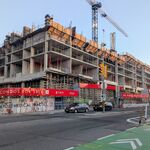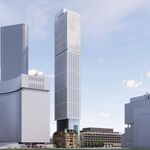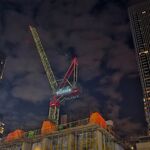Re Hospitals:
The reason hospitals tend to locate close to each other is a phenomenon called clustering. Similar things occur with certain industries (high tech for example). It makes sense to have the cancer clinic near the hospital. Ronald McDonald House isn't where it is by accident. Some clusters form organically, while some are created artificially through policy decisions.
An example of this trying to be done purposefully is the Durham Region Consolidated Courthouse. By placing it in downtown Oshawa, the hope is that the presence of the courthouse will attract some law firms and other law-related businesses to locate in downtown.
Re Suburbs:
I have experienced both urban and suburban living. I grew up in the suburbs (Ottawa mind you, but suburbs are suburbs), but lived and worked in downtown Toronto for 5 years. There are two main things wrong with the suburbs: scale, and orientation.
Scale: "Traditional" neighbourhoods are built around pedestrians, so naturally the neighbourhoods are built at a scale so that most of the daily essentials are within a 5 minute walk. The suburbs were primarily designed around the car. The 5 minute rule still applies, but it has been replaced with a 5 minute drive instead of a 5 minute walk. The built form, the location of the necessities relative to where people live has all been blown up in scale, to the point where it is difficult to work at a human scale.
Orientation: "Traditional" neighbourhoods had a clear and defined focus point. It could be a single point (traditionally a Square), or could be a Main Street. Either way, there was a clear and defined orientation to the neighbourhood. This focus point was also likely the location of the primary transit connection to/from the neighbourhood. Current suburban neighbourhoods do not have these characteristics. The Main Street has been replaced with the shopping mall, which itself is really an inward-oriented main street.
Neither of these two issues are insurmountable. The suburbs shouldn't be looked at as this massive wasteland of tract housing, but rather as a collection of communities, albeit in many cases very poorly designed communities. When you break suburbs down to the neighbourhood scale, the task of making them more pedestrian and transit friendly becomes a more manageable task.
Creating defined neighbourhood centres with good access to transit, while it may be expensive in the short term, will be worth it. When given the proper catalyst (in this case transit), it's pretty amazing to see how neighbourhoods tend to re-orient themselves.
That's my rant. It's late, so I may read this tomorrow and it may not make perfect sense, but there it is. It's kind of hard to summarize my rebuttal to so many points in a single post.
The reason hospitals tend to locate close to each other is a phenomenon called clustering. Similar things occur with certain industries (high tech for example). It makes sense to have the cancer clinic near the hospital. Ronald McDonald House isn't where it is by accident. Some clusters form organically, while some are created artificially through policy decisions.
An example of this trying to be done purposefully is the Durham Region Consolidated Courthouse. By placing it in downtown Oshawa, the hope is that the presence of the courthouse will attract some law firms and other law-related businesses to locate in downtown.
Re Suburbs:
I have experienced both urban and suburban living. I grew up in the suburbs (Ottawa mind you, but suburbs are suburbs), but lived and worked in downtown Toronto for 5 years. There are two main things wrong with the suburbs: scale, and orientation.
Scale: "Traditional" neighbourhoods are built around pedestrians, so naturally the neighbourhoods are built at a scale so that most of the daily essentials are within a 5 minute walk. The suburbs were primarily designed around the car. The 5 minute rule still applies, but it has been replaced with a 5 minute drive instead of a 5 minute walk. The built form, the location of the necessities relative to where people live has all been blown up in scale, to the point where it is difficult to work at a human scale.
Orientation: "Traditional" neighbourhoods had a clear and defined focus point. It could be a single point (traditionally a Square), or could be a Main Street. Either way, there was a clear and defined orientation to the neighbourhood. This focus point was also likely the location of the primary transit connection to/from the neighbourhood. Current suburban neighbourhoods do not have these characteristics. The Main Street has been replaced with the shopping mall, which itself is really an inward-oriented main street.
Neither of these two issues are insurmountable. The suburbs shouldn't be looked at as this massive wasteland of tract housing, but rather as a collection of communities, albeit in many cases very poorly designed communities. When you break suburbs down to the neighbourhood scale, the task of making them more pedestrian and transit friendly becomes a more manageable task.
Creating defined neighbourhood centres with good access to transit, while it may be expensive in the short term, will be worth it. When given the proper catalyst (in this case transit), it's pretty amazing to see how neighbourhoods tend to re-orient themselves.
That's my rant. It's late, so I may read this tomorrow and it may not make perfect sense, but there it is. It's kind of hard to summarize my rebuttal to so many points in a single post.
















